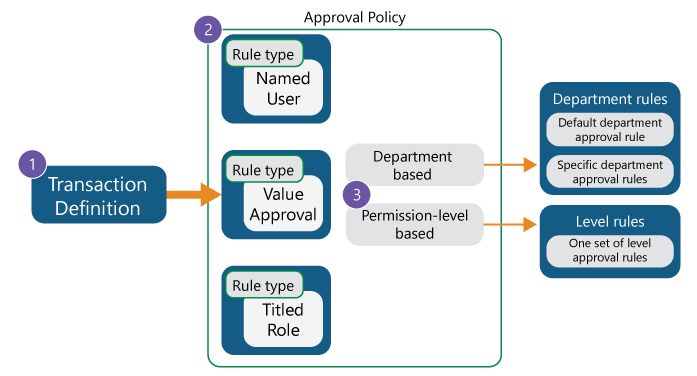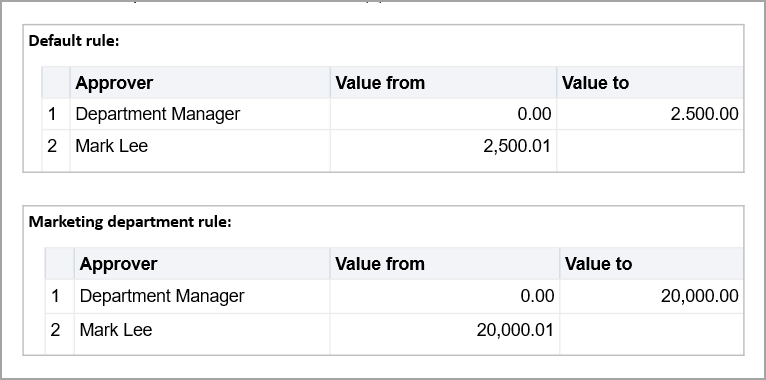About purchasing approvals
Use purchasing approvals to implement your organization’s internal approval processes, which help to ensure that spending is authorized and correct. Approval processes generally address which transactions need approval and by whom.
Setting up and managing purchasing approvals in Sage Intacct is flexible. You decide which purchasing transactions need approval, who needs to approve, the sequence of approval, and whether any approvals are based on the transaction amount.
Who can approve what?
Transactions using the following transaction definition template types can be approved:
- Quote
- Order
- Invoice
And, the following user types can be approvers:
- Business
- Employee
- Project Manager
- Payment Approver
- Platform
- Warehouse
Approval policies
Approval policies are the core piece of your purchasing approvals because they define the approval processes for your transaction definitions. You can route approvals for transactions to specific people or groups, to people in specific roles, or to people based on the transaction amount. Or, you can route approvals using a combination of these approaches.
For example, in a small organization, you might route a purchase requisition to the employee's manager and then to a specific person in the Finance department. In a large organization, duties might be more segregated and decision-making might be more centralized. Therefore, in this case, you might route a purchase requisition to the employee's manager and then to other users based on the purchase amount.
The following graphic illustrates the key concepts about approval policies:

-
You can have one approval policy per transaction definition.
-
The rule types in the approval policy determine the approval routing. You can specify one or more rule types—specific user, user group, value approval, or titled role—to create the approval processes that you need.
-
If a policy includes a value approval rule type , you'll define the users with the correct spending authority to approve transactions up to specific purchase amounts.
A department-based value approval includes a default department approval rule and, optionally, specific department approval rules.
A permission-level based value approval contains one set of level approval rules.
Rule types
The rule types control how the approvals are routed for a transaction.
| To route to ... | Select the following as the rule type ... |
|---|---|
|
A specific user or user group |
Select User Level or User Group Level as the rule type, then select named user. Only users or groups with appropriate purchasing approval permissions for the entity, department, or territory appear in the list. |
|
Users who approve the transaction value according to their spending authority. |
One of these value approvals:
If you delegate a value-based approval, check to make sure the delegate has the required approval value permission.
|
|
A manager in a specific role |
One of these titled roles:
|
To approve a purchasing transaction, a user must be subscribed to the Purchasing application and have appropriate approval permissions.
Learn more about approval policies and rule types.
Department value approvals and rule sets
Rule sets apply only to department value approvals. They minimize the overhead of managing the extra rules that are needed for routing approvals that are based on purchase amount by department. For a Value Approval - Department or Value Approval - Transaction Department rule type, you need to associate a rule set to the rule type. The rule set defines the approvers that you want and their approval amounts. A rule set includes:
- The default value approval rule for any department without its own specific value approval rule
- Any extra value approval rules for any departments that need their own specific rules
Assume that you want approvals for purchase requisitions to be routed in the following sequence:
- The submitter's manager
- Users who approve based on their spending authority (purchase amounts)
- A final user who gives the last signoff
The approval policy for the Purchase Requisition transaction definition might look like the following:

Where the Purchase Requisitions rule set includes a default rule for any department and a specific rule for the Marketing department:

If a purchase requisition is submitted for R6,000 for any department other than the Marketing department, the approvals would go to:
- The submitter's manager
- Department manager
- Mark Lee
- Frank Smith
If the purchase requisition had been submitted for the Marketing department, the approvals would go to:
- The submitter's manager
- Marketing department manager (Mark Lee doesn’t need to approve in this case because the Marketing Department Manager has authority to approve up to R20,000)
- Frank Smith
Learn more about rule sets for department value approvals.
Permission-level value approvals and level rules
Permission-based value approvals also need extra rules for routing approvals based on purchase amount. If you specify Value Approval or Value Approval - Progressive, ensure that the level approval rules define the levels of approval you want and the approval amounts at each level. Any user with permission approval for a given level can approve.
Assume that you want approvals for purchase requisitions to be routed in the following sequence:
- The submitter's manager
- Each level approver until the purchase falls within the level's approval amount
The approval policy for the Purchase Requisition transaction definition might look like the following:

Where the level value approval rule for Value Approval - Progressive rule type is defined as:

For a purchase requisition of R1,500, the approvals would go to:
- The submitter's manager
- Users with Level 1 purchasing approval permission
- Users with Level 2 purchasing approval permission
If the rule type in the policy had been Value Approval with the same level value approval rule, the approvals would go to:
- The submitter's manager
- Users with Level 2 purchasing approval permission (approval is not progressive through the levels and goes directly to the level in which the purchase amount falls).
Learn more about the value approval rules for permission-based level value approvals.
Automatic approvals
Sometimes, a step in the approval sequence is automatically approved and approval progresses to the next approver. Automatic approval happens when:
-
The last person to touch a transaction, the submitter or approver, is also the next approver in the sequence, unless the approval is for a permission-based value approval because a level can have more than one required approver
- For either a department-based or permission-based value approval, the amount falls below the minimum amount for the first approver or the first level
Email notification
Want to let approvers know when their approval is needed? You can have email notifications sent automatically by enabling Email notifications in your organization's configuration of the Purchasing application. To receive the email notifications, the approvers need to have their preferences set.
Approval delegation
Want to keep approvals moving even while approvers are away? Automatically reroute approvals by enabling Approval delegation in your organization's Purchasing configuration and assigning a delegate for each approver. When an approver sets themselves to out-of-office in their preferences, Sage Intacct sends approvals for any new purchase transactions to the approver's delegate.
Learn more about approval delegation.
